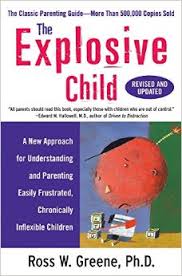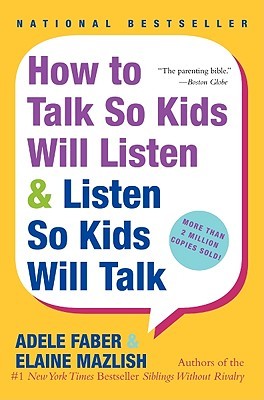Three Books Every Parent Of A Challenging Child Should Read



If you have a challenging child and are looking for helpful parenting books to read, I would highly recommend starting with the following three books:
The Explosive Child is flat out the best book there is for understanding the origins of challenging behavior and working with the problems that underlie it.
The Kazdin Method for Parenting the Defiant Child teaches parents how to create effective reward charts. Reward charts are powerful tools for working with challenging behavior. They are an essential addition to every parent’s tool box, and a great supplement to the methods presented in The Explosive Child.
How to Talk So Kids Will Listen picks up where The Explosive Child and The Kazdin Method leave off. It’s important to balance our efforts to manage challenging behavior with consistent work aimed at fostering a positive parent-parent child relationship. How to Talk So Kids Will Listen shows how to cultivate a close, open and fun relationship with our child even as we work to modify his or her challenging behavior.
Below I have summarized the three main takeaways from each of these wonderful books.
The Explosive Child: A New Approach for Understanding and Parenting Easily Frustrated, Chronically Inflexible Children, Ross Greene
1. “Children do well if they can.”
When our kids misbehave, it can feel like willfulness, opposition, defiance, you name it. It feels like they don’t want to do well, and for caring parents like us, it drives us crazy. Ross Greene, in The Explosive Child, helps us see that our challenging kids actually do want to please us, but problems with frustration tolerance, and inflexibility can make it so that they can’t do well even though they want to.
2. The best approach to challenging behavior is to teach challenging kids the skills they need to do well.
Punishments and rewards don’t help with most challenging behavior because they affect a child’s motivation to cooperate. Since challenging children are lacking the skills they need to cooperate consistently, no amount of motivational help will eliminate challenging behavior in the long run. Challenging children, instead, need to be taught the skills of frustration tolerance and flexibility so that they will be able to succeed.
3. Problem solving teaches challenging kids the skills they need to do well.
Greene emphasizes the power of problem solving to teach kids valuable life skills. Problem solving is not only a great way to solve individual problems, but it also actually helps kids develop the frustration tolerance and flexibility they need to do well.
(To read more about The Explosive Child, click this link to see my review: “Review of The Explosive Child, by Ross Greene“).
The Kazdin Method for Parenting the Defiant Child, Alan Kazdin
You might be saying, “I’ve tried reward charts, and they don’t work.” This is a common experience because creating an effective reward chart isn’t as easy as it might seem. Kazdin identifies the key ingredients of reward charts that work. In his book you’ll learn to:
1. Determine a “positive opposite” behavior.
It’s much more effective to reward a child for doing a positive behavior, than it is to reward him or her for not doing a negative behavior. Kazdin recommends building reward charts around reinforcing a positive behavior that is the opposite of the behavior that you want to eliminate. Rewarding the child for doing the positive opposite behavior automatically reduces the frequency of the negative behavior you want to eliminate.
2. Select appropriate rewards.
Kazdin recommends small rewards that a child can earn quickly, and a large reward that the child is working towards over time. This combination of small and big rewards is more effective than either small or large rewards alone. The rewards do not need to be material rewards. Great rewards are special activities, or special time with parents.
3. Break the desired behavior down into small pieces.
A good reward chart breaks the desired behavior down into smaller parts that can be separately rewarded. This gives the child more opportunities for success, and gives the child a new chance to succeed quickly after a failure has occurred. For example, if you want your child to get ready for school on time, giving him or her a single point for being ready on time would be much less effective than giving the child a point for getting up at a specified time, another for getting dressed by a certain time, another for brushing teeth on time, etc.
A well designed and executed reward chart is a quick and effect method for reducing many types of challenging behavior.
(To read more about The Kazdin Method, click this link to see my blog: “Sticker Charts/Reward Charts/Behavior Charts: The Five Most Common Mistakes Parents Make When Using Reward Charts”).
How to Talk So Kids Will Listen & Listen So That Kids Will Talk, Adele Faber and Elaine Mazlish
1. “There is a direct connection between how kids feel and how they behave.”
Bad feelings (anger, sadness, anxiety) are frequently the cause of a child’s “bad” behavior. Helping children cope with these difficult feelings is the best path to “good” behavior.
2. The best way to help kids to feel good (and to feel good about themselves) is to accept and respect their feelings.
When we listen to our child’s feelings with full attention and when we take his or her upset feelings seriously (even when the situation seems small), we help our child to develop the ability to accept and manage his or her own feelings. Today we recognize that this type of emotional intelligence is as important for success in life as IQ.
Accepting and validating our child’s feelings does not mean that we necessarily agree with the feelings. It is soothing to anyone merely to have his or her feelings acknowledged and understood sympathetically, but for kids this is essential. When we deny our own children’s feelings, it often leads to arguments, hostility, and poor cooperation.
3. Punishments should be abandoned in favor of problem solving.
It is tempting to use punishments in response to bad behavior because they get a child’s attention. The frequent rationale for using punishments is that they “teach right from wrong.” However, punishments actually divert our child’s attention away from reflecting on (and taking responsibility for) his or her misbehavior. Punishments, instead, focus our child on feeling resentment towards us. Faber and Mazlish suggest that parents and children use problem solving techniques to resolve the conflict or issue that lies behind misbehavior.
How to Talk is full of real life examples that can be immediately applied in your own home.
